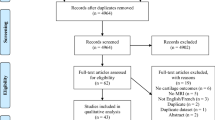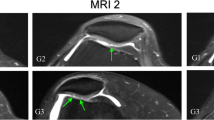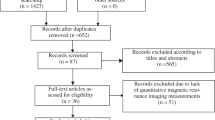Abstract
Objective
The metatarsophalangeal joints (MTPJ) are the only joints that bear weight directly through synovium. The purpose of this study was to determine whether there is an association between synovial stresses during running and increases in volume of joint fluid.
Materials and methods
This was a prospective case controlled study (nine healthy athlete volunteers acting as own controls). High-resolution coronal 3D T2W magnetic resonance imaging of the MTPJs were obtained following 24 h rest and after a 30-min run. The volume of joint fluid in each MTPJ (n = 90) was measured by two independent observers using an automated propagating segmentation tool.
Results
The median volume of synovial fluid in the MTPJs at rest was 0.018 ml (inter-quartile range (IQ) range 0.005–0.04) and after running 0.019 ml (IQ range 0.005–0.04, p = 0.34, 99% confidence interval (CI), 0.330.35). The volume of fluid in the MTPJs of the great toes was substantially larger than other toes (0.152 ml at rest, 0.154 ml after exercise, p = 0.903). Median volumes decrease from second to fifth MTPJs (0.032–0.007 ml at rest and 0.035–0.004 ml after exercise). Subset analysis for each toe revealed no significant difference in volumes before and after running (p = 0.39 to p = 0.9). The inter-rater reliability for observer measurements was good with an intra-class correlation of 0.70 (95% CI, 0.60 to 0.78).
Conclusion
It appears to be normal to find synovial fluid, particularly in the MTPJs of the great toes, of athletes at rest and after running. There does not appear to be an association between moderate distance running and an increase in the volume of synovial fluid.





Similar content being viewed by others
References
Krell JB, Stefanyshyn DJ. The relationship between extension of the metatarsophalangeal joint and sprint time for 100 m Olympic athletes. J Sports Sci 2006; 24: 175–180.
Stefanyshyn DJ, Nigg BM. Mechanical energy contribution of the metatarsophalangeal joint to running and sprinting. J Biomech 1997; 30: 1081–1085.
Momberger TS, Levick JR, Mason RM. Hyaluronan secretion by synoviocytes is mechanosensitive. Matrix Biol 2005; 24: 510–519.
Momberger TS, Levick JR, Mason RM. Mechanosensitive synoviocytes: a Ca2+-PKCalpha-MAP kinase pathway contributes to stretch-induced hyaluronan synthesis in vitro. Matrix Biol 2006; 25: 306–316.
Coleman PJ, Scott D, Ray J, Mason RM, Levick JR. Hyaluron secretion into the synovial cavity of rabbit knees and comparison with albumin turnover. J Physiol 1997; 503: 645–656.
Dowthwaite GP, Ward AC, Flannely J, et al. The effect of mechanical strain on hyaluronan metabolism in embryonic fibrocartilage cells. Matrix Biol 1999; 18: 523–532.
Schweitzer ME, White LM. Does altered biomechanics cause marrow edema? Radiology 1996; 198: 851–853.
Major NM, Helms CA. MR imaging of the knee: findings in asymptomatic collegiate basketball players. AJR Am J Roentgenol 2002; 179: 641–644.
Schueller-Weidekamm C, Schueller G, Uffmann M, Bader TR. Does marathon running cause acute lesions of the knee? Evaluation with magnetic resonance imaging. Eur Radiol 2006; 16: 2179–2185.
Moss SG, Schweitzer ME, Jacobson JA, et al. Hip joint fluid: detection and distribution at MR imaging and US with cadaveric correlation. Radiology 1998; 208: 43–48.
Schweitzer ME, Magbalon MJ, Fenlin JM, Frieman BG, Ehrlich S, Epstein RE. Effusion criteria and clinical importance of glenohumeral joint fluid: MR imaging evaluation. Radiology 1995; 194: 821–824.
Schweitzer ME, van Leersum M, Ehrlich SS, Wapner K. Fluid in normal and abnormal ankle joints: amount and distribution as seen on MR images. AJR Am J Roentgenol 1994; 162: 111–114.
Lohman M, Kivisaari A, Vehmas T, Kallio P, Malmivaara A, Kivisaari L. MRI abnormalities of foot and ankle in asymptomatic, physically active individuals. Skelet Radiol 2001;30:61–66.
Luukkainen RK, Saltyshev M, Koski JM, Huhtala HS. Relationship between clinically detected joint swelling and effusion diagnosed by ultrasonography in metatarsophalangeal and talocrural joints in patients with rheumatoid arthritis. Clin Exp Rheumatol 2003; 21: 632–634.
Segami N, Suzuki T, Sato J, Miyamaru M, Nishimura M, Yoshimura H. Does joint effusion on T2 magnetic resonance images reflect synovitis? Part 3. Comparison of histologic findings of arthroscopically obtained synovium in internal derangements of the temporomandibular joint. Oral Surg Oral Med Oral Pathol Oral Radiol Endod 2003; 95: 761–766.
Betrouni N, Dewalle AS, Puech P, Vermandel M, Rousseau J. 3D delineation of prostate, rectum and bladder on MR images. Comput Med Imaging Graph 2008; 32: 622–630.
Tutschek B, Sahn DJ. Semi-automatic segmentation of fetal cardiac cavities: progress towards an automated fetal echocardiogram. Ultrasound Obstet Gynecol 2008; 32: 176–180.
Wijesooriya K, Weiss E, Dill V, et al. Quantifying the accuracy of automated structure segmentation in 4D CT images using a deformable image registration algorithm. Med Phys 2008; 35: 1251–1260.
Aristophanous M, Penney BC, Pelizzari CA. The development and testing of a digital PET phantom for the evaluation of tumor volume segmentation techniques. Med Phys 2008; 35: 3331–3342.
Dehmeshki J, Amin H, Valdivieso M, Ye X. Segmentation of pulmonary nodules in thoracic CT scans: a region growing approach. IEEE Trans Med Imaging 2008; 27: 467–480.
Fabel M, von Tengg-Kobligk H, Giesel FL, et al. Semi-automated volumetric analysis of lymph node metastases in patients with malignant melanoma stage III/IV—a feasibility study. Eur Radiol 2008; 18: 1114–1122.
Kollorz EK, Hahn DA, Linke R, Goecke TW, Hornegger J, Kuwert T. Quantification of thyroid volume using 3-D ultrasound imaging. IEEE Trans Med Imaging 2008; 27: 457–466.
Street E, Hadjiiski L, Sahiner B, et al. Automated volume analysis of head and neck lesions on CT scans using 3D level set segmentation. Med Phys 2007; 34: 4399–4408.
Heuck AF, Steiger P, Stoller DW, Gluer CC, Genant HK. Quantification of knee joint fluid volume by MR imaging and CT using three-dimensional data processing. J Comput Assist Tomogr 1989; 13: 287–293.
Ostergaard M, Stoltenberg M, Henriksen O, Lorenzen I. The accuracy of MRI-determined synovial membrane and joint effusion volumes in arthritis. A comparison of pre- and post-aspiration volumes. Scand J Rheumatol 1995; 24: 305–311.
Shrout P, Fleiss J. Intraclass correlations: uses in assessing rater reliability. Psychol Bull 1979; 2: 420–428.
Rosset A, Spadola L, Ratib O. OsiriX: an open-source software for navigating in multidimensional DICOM images. J Digit Imaging 2004; 17: 205–216.
Author information
Authors and Affiliations
Corresponding author
Additional information
This study was funded by a research grant from Action Arthritis.
Rights and permissions
About this article
Cite this article
Kingston, AR., Toms, A.P., Ghosh-Ray, S. et al. Does running cause metatarsophalangeal joint effusions? A comparison of synovial fluid volumes on MRI in athletes before and after running. Skeletal Radiol 38, 499–504 (2009). https://doi.org/10.1007/s00256-008-0641-2
Received:
Revised:
Accepted:
Published:
Issue Date:
DOI: https://doi.org/10.1007/s00256-008-0641-2




